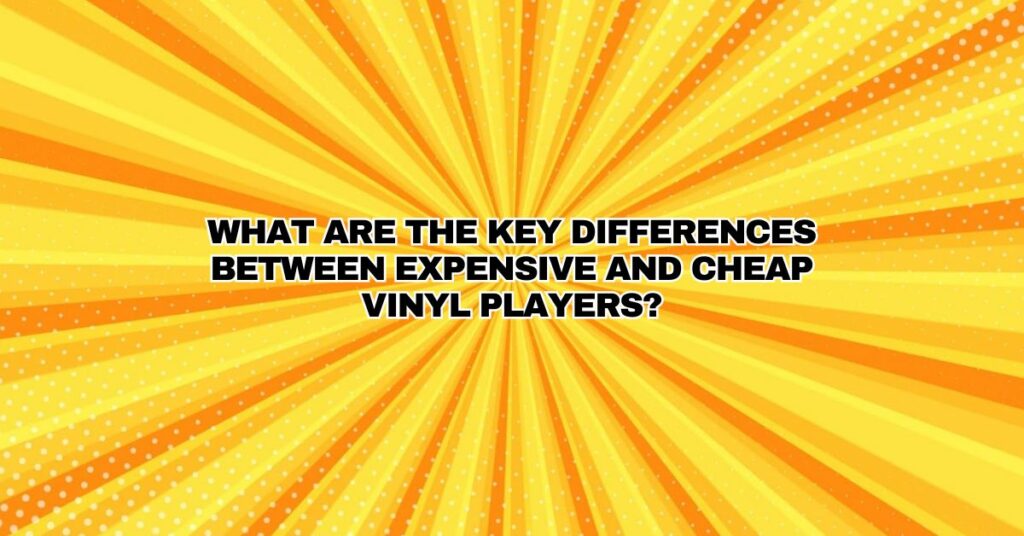Vinyl records have made a remarkable resurgence in the music industry, and with that revival, there’s an increasing demand for turntables. Vinyl enthusiasts, both newcomers and seasoned collectors, often grapple with the choice between expensive and cheap vinyl players. In this comprehensive guide, we’ll explore the key differences that set these two categories of turntables apart.
1. Build Quality and Materials:
Expensive Turntables: High-end turntables are typically constructed with superior materials and craftsmanship. They often feature heavy, non-resonant plinths made from materials like MDF, acrylic, or metal. The platter, tonearm, and other components are precisely engineered for maximum stability and minimal vibration.
Cheap Turntables: Inexpensive turntables often cut corners with materials and build quality. They may use lightweight and resonant plastics for the plinth, which can lead to vibrations and interference with sound quality. The overall construction may be less robust and prone to wear and tear over time.
2. Platter Design:
Expensive Turntables: High-end turntables feature precision-engineered platters that are often heavier and made from materials like acrylic, glass, or metal. These heavy platters provide stable rotation, reducing speed fluctuations and improving sound quality.
Cheap Turntables: Inexpensive turntables may have lightweight platters made from plastic. These platters are more susceptible to speed variations and vibrations, which can negatively affect sound quality.
3. Motor and Drive System:
Expensive Turntables: High-end turntables are equipped with high-torque, direct-drive or belt-drive motors. These motors are carefully engineered for speed accuracy and stability. Belt-driven turntables often use high-quality belts that minimize vibration and noise.
Cheap Turntables: Inexpensive turntables may use lower-quality motors and drive systems. The motors may lack the precision and stability of their high-end counterparts, resulting in less accurate playback and speed consistency.
4. Tonearm and Cartridge:
Expensive Turntables: High-end turntables are often paired with superior tonearms and cartridges. These components are engineered to minimize tracking errors and maximize sound quality. They may offer adjustable counterweights and anti-skate mechanisms for precise setup.
Cheap Turntables: Inexpensive turntables typically come with basic tonearms and cartridges. These components may lack the features necessary for precise tracking and setup. As a result, the sound quality may not reach the same level as on high-end systems.
5. Isolation and Damping:
Expensive Turntables: High-end turntables prioritize isolation and damping to reduce external vibrations and resonance. They often include sophisticated suspension systems and shock-absorbing feet to ensure stable playback.
Cheap Turntables: Inexpensive turntables may lack proper isolation and damping mechanisms. They are more susceptible to external vibrations, including footfalls and room resonances, which can negatively impact sound quality.
6. Speed Control and Stability:
Expensive Turntables: High-end turntables feature precise speed control mechanisms, often with digital speed stabilization. This ensures that the turntable maintains accurate playback speeds for optimal sound quality.
Cheap Turntables: Inexpensive turntables may have less sophisticated speed control systems, leading to speed fluctuations and inconsistencies during playback.
7. Upgradability:
Expensive Turntables: High-end turntables are often designed with upgradability in mind. Audiophiles can invest in high-quality cartridges, tonearms, and other components to further enhance sound quality.
Cheap Turntables: Inexpensive turntables may have limited upgradability options. Their designs may not easily accommodate upgrades, making it challenging to improve their performance over time.
8. Sound Quality:
Expensive Turntables: High-end turntables are known for their superior sound quality. They deliver detailed, dynamic, and nuanced audio that captures the full richness of vinyl recordings.
Cheap Turntables: Inexpensive turntables may offer satisfactory sound quality for casual listening but are often unable to reproduce the full sonic potential of vinyl records.
Conclusion: Making the Right Choice:
The choice between expensive and cheap vinyl players ultimately depends on your budget, listening priorities, and long-term goals. High-end turntables provide a superior listening experience, but they come at a premium cost. In contrast, inexpensive turntables are accessible and can be a great entry point for vinyl enthusiasts on a budget.
When making your decision, it’s essential to consider what matters most to you: whether it’s the pursuit of audiophile-grade sound quality or a more casual and cost-effective vinyl experience. Regardless of your choice, vinyl records offer a unique and immersive way to enjoy music, and the joy of collecting and listening to them is a timeless pursuit.


